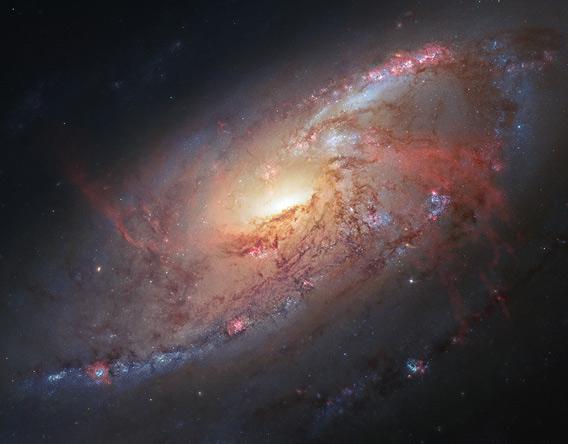Our Milky Way is a pretty nice place to live. It has the same dangers as any large galaxy—black holes, supernovae, the odd gamma-ray burst or two—but they seem relatively mild compared to some other galaxies.
Especially when you look at the nearby spiral galaxy M 106. If you lived there, you’d be in danger of getting zapped by a cosmic death ray thousands of light years long!
At first, you might be overcome by the beauty of this photo. I wouldn’t blame you. It’s primarily made of images taken of M106 by the Hubble Space Telescope, but combined with images and data taken by the amazing astrophotographers Robert Gendler and Jay GaBany using ground-based telescopes.
You can see the yellowish glow of older stars in the center of the galaxy, making up its central bulge, or “hub”. Cascading out are two lovely spiral arms, glowing blue due to the fierce combined light of millions upon millions of hot, young, massive stars. Festooned across the arms are long strings of opaque dust clouds, blocking the blue light and appearing dark. So far, though spectacular, this is pretty mainstream spiral galaxy stuff.
Then you see those red frills, streamers of gas at odd angles to the rest of the galaxy, one each on opposite sides of the galaxy’s core. These are called its anomalous arms, because they don’t line up well at all with M106’s more obvious spiral arms. The red color is a giveaway that we’re seeing gas being warmed by an outside source; hydrogen glows at that color when excited. So what’s the engine behind that?
It turns out, that gas is being zapped by twin blasts of energy coming from material being voraciously consumed by the galaxy’s supermassive central black hole.
I know. It was cool just writing that sentence.
Every big galaxy has a supermassive black hole in its core. The Milky Way has one, and it has about 4 million times the mass of the Sun. The black hole at M106’s heart is about 30 million times the mass of our Sun. Besides being heftier it’s also actively feeding, gobbling down material swirling around it (our own galaxy’s black hole is quiescent; that is, not eating anything at the moment). As the matter falls in, it forms a huge flat disk called an accretion disk. Heated to millions of degrees and under the sway of unimaginably strong magnetic fields, some of that material blasts away from the black hole at high speeds, going up and down relative to the plane of the disk.
In M106, that disk is tipped with respect to the galaxy itself. The jets or beams of matter and energy scream away from the black hole at an angle of about 30° from the galaxy’s plane. That means they encounter material on their way out, slamming into it and heating it up violently.

That’s what’s causing the anomalous arms! The gas and dust being rammed by the high-energy beams of material from the galaxy’s core heat up and glow. In the Hubble image they emit a bit of red light due to the prevalent hydrogen. But when you look at M106 using the Spitzer (which sees in infrared) and Chandra (X-rays) space telescopes, the picture is clearer. X-rays are generated in very violent events. In this case, shock waves created when the high-speed material slams into the relatively stationary gas heats that material to well over a million degrees, which then emits X-rays. This super-heated matter in turn heats up material around it, making it glow in infrared, too. That’s no surprise, since the jets blast out X-ray energy at a rate millions of times more luminous than our Sun.
That’s phenomenal. Active galaxies—ones with supermassive black holes eating matter and blasting out high-energy radiation—are not uncommon, but it’s nice to have one this close so we can study it. M106 is only about 25 million light years away, which is nearby for these sorts of things. Because it’s close we can study it in detail and understand what it’s doing; at greater distances the black hole jets would’ve been harder to distinguish from the galaxy itself. This means the behavior of far more distant galaxies can be understood even if we can’t make out the details; we just have to compare the overall behavior with ones like M106 where we have sharper vision.
So it’s a boon to astronomy to have M106 handy. But when I look at it, I can feel the hair on the back of my neck stir a bit. Surely some of that is the simple scientific thrill, a frisson of intellectual excitement … but I suspect more than a little is knowing that fearsome forces run rampant in some galaxies, blasting energies out that dwarf our Sun and crush our puny human sense of scale.
Our Milky Way really is a good place for us to live. Because when we look elsewhere, it becomes clear that there but for the grace of galaxies go we.
